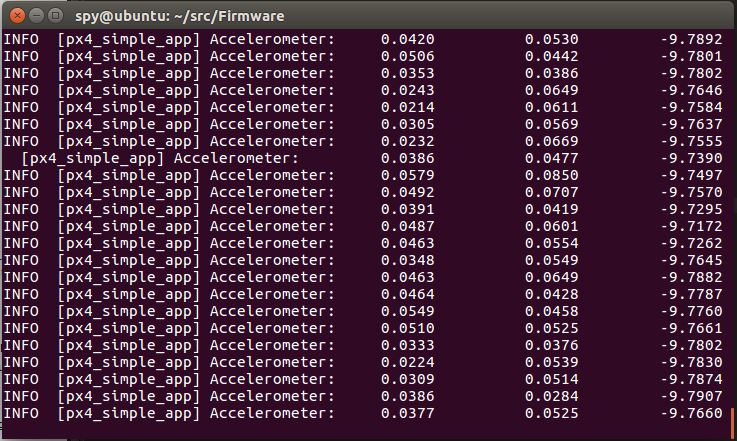[pixhawk笔记]4-如何写一个简单的应用程序
本文主要内容来自于:https://dev.px4.io/en/tutorials/tutorial_hello_sky.html,并对文档中的部分问题进行更正。
本文假设已经建立好开发环境并能正确编译,关于编译过程,可参见本人博客中的[pixhawk笔记]1-编译过程。
程序员学习一门语言时第一个例子一般是学习怎么写一个“Hello World”,本文中的简单程序就是类似于该功能,能够让读者搞明白如何实现一个px4程序。
- 最小程序
进入Firmware/src/examples/目录,在px4_simple_app文件夹下面创建px4_simple_app.c文件(该文件已经存在于源码中,为了提高学习效果,建议将其删除,重新写)。
在其中键入如下代码:
#include <px4_config.h> #include <px4_tasks.h> #include <px4_posix.h> #include <unistd.h> #include <stdio.h> #include <poll.h> #include <string.h> #include <uORB/uORB.h> #include <uORB/topics/sensor_combined.h> #include <uORB/topics/vehicle_attitude.h> __EXPORT int px4_simple_app_main(int argc, char *argv[]); int px4_simple_app_main(int argc, char *argv[]) { PX4_INFO("Hello Sky!"); return OK; }该代码中有默认头和默认的主函数。
- 在Nuttx系统中注册应用并编译
为了使该程序能够编译进固件,需要在系统的cmake文件中注册该程序,笔者使用的是pixhawk2,对应的cmake文件是:Firmware/cmake/config/nuttx_px4_fmu-v3_default.cmake,其他平台可以找到对应的cmake文件。
然后在该文件中config_moule_list代码段加入模块路径:examples/px4_simple_app笔者发现官方文档有问题,加入.c文件后,还得在px4_simple_app文件夹下面建立CMakeLists.txt文件,否则编译不过去。建立CMakeLists.txt并加入如下内容:px4_add_module( MODULE examples__px4_simple_app MAIN px4_simple_app STACK_MAIN 2000 SRCS px4_simple_app.c DEPENDS platforms__common )
然后编译之: -
make px4fmu-v3_default编译通过后编译并上传
make px4fmu-v3_default upload - 连接控制台
Ubuntu下面可以通过screen来连接px4控制台,使用如下命令安装screen:
sudo apt-get install screen
然后使用如下命令连接px4控制台:
screen /dev/ttyXXX BAUDRATE 8N1
其中,ttyXXX为pixhawk对应的串口设备,如下命令可以列出串口设备列表:
ls /dev/tty*通过插拔pixhawk并对比插拔前后的列表变化,可以确定pixhawk对应的串口设备ID。
通过对比,本机的pixhawk使用的ttyACM0但是笔者这么连接全是乱码……不知何故o(╯□╰)o……
尝试使用MAVLink shell来连接控制台,先使用pip安装pymavlink和pyserial
sudo pip install pymavlink pyserial
GFW的原因,使用pip安装时经常出现连接超时的问题。笔者使用下载安装包离线安装的方法。
然后使用mavlink shell 来连接:
./Tools/mavlink_shell.py /dev/ttyACM0
连接成功后出现如下界面:

控制太nsh即为px4代码运行的nuttx操作系统的shell,可在此运行系统内置命令,由于我们已经将写的代码注册到nuttx,所以可以直接运行该应用。键入:px4_simple_app,则出现如下运行界面:
打印出Hello Sky!的字符串,证明px4_simple_app.c中的代码得到了执行。
-
订阅传感器数据
上面的例子只是为了演示如何写一个px4上运行的应用,为了做一些有用的事情,下面演示如何获得传感器数据并显示出来。
在px4中,各个应用之间传递的消息称为“主题”(topic),这些消息通过uORB进行传递,当需要传递传感器信息时,我们感兴趣的是 sensor_combined 主题,该主题将整个系统的传感器信息保持同步。
可以通过如下代码订阅该主题:#include <uORB/topics/sensor_combined.h> .. int sensor_sub_fd = orb_subscribe(ORB_ID(sensor_combined));
得到的sensor_sub_fd是一个主题句柄,使用该句柄可以通过阻塞等待来获得新的传感器数据。 阻塞使该应用开始休眠,知道新数据产生后将该应用唤醒,在等待期间不消耗任何CPU运算。可使用POSIX中的poll函数来实现该功能,整个代码如下:#include <poll.h> #include <uORB/topics/sensor_combined.h> .. int sensor_sub_fd = orb_subscribe(ORB_ID(sensor_combined)); /* one could wait for multiple topics with this technique, just using one here */ px4_pollfd_struct_t fds[] = { { .fd = sensor_sub_fd, .events = POLLIN }, }; while (true) { /* wait for sensor update of 1 file descriptor for 1000 ms (1 second) */ px4_poll(fds, 1, 1000); .. if (fds[0].revents & POLLIN) { /* obtained data for the first file descriptor */ struct sensor_combined_s raw; /* copy sensors raw data into local buffer */ orb_copy(ORB_ID(sensor_combined), sensor_sub_fd, &raw); PX4_INFO("Accelerometer:\t%8.4f\t%8.4f\t%8.4f", (double)raw.accelerometer_m_s2[0], (double)raw.accelerometer_m_s2[1], (double)raw.accelerometer_m_s2[2]); } }
注意到上面的代码与源码里给出的有出入,px4_poll无返回值,因为笔者发现网上下载的源码有返回值而没有用,编译时会在gcc中产生错误而编译不通过。所以采用无返回值的形式。
然后编译,下载,并使用mavlink shell连接,运行px4_simple_app后控制台输出如下:

- 发布数据
上面的例子给出了如何通过uORB获得订阅数据,下面给出如何发布数据。发布的接口比较简单:使用如下代码初始化要发布的内容:
#include <uORB/topics/vehicle_attitude.h> .. /* advertise attitude topic */ struct vehicle_attitude_s att; memset(&att, 0, sizeof(att)); orb_advert_t att_pub_fd = orb_advertise(ORB_ID(vehicle_attitude), &att);
当传感器信息获得后,在主循环中使用如下代码来发布信息
orb_publish(ORB_ID(vehicle_attitude), att_pub_fd, &att);
完整代码如下:
#include <px4_config.h> #include <px4_tasks.h> #include <px4_posix.h> #include <unistd.h> #include <stdio.h> #include <poll.h> #include <string.h> #include <uORB/uORB.h> #include <uORB/topics/sensor_combined.h> #include <uORB/topics/vehicle_attitude.h> __EXPORT int px4_simple_app_main(int argc, char *argv[]); int px4_simple_app_main(int argc, char *argv[]) { PX4_INFO("Hello Sky!"); int sensor_sub_fd = orb_subscribe(ORB_ID(sensor_combined)); orb_set_interval(sensor_sub_fd,200);/* limit the update rate to 5 Hz */ struct vehicle_attitude_s att; memset(&att,0,sizeof(att)); orb_advert_t att_pub = orb_advertise(ORB_ID(vehicle_attitude),&att); px4_pollfd_struct_t fds[] = { {.fd = sensor_sub_fd, .events = POLLIN}, }; int error_counter = 0; for(int i=0;i<5;i++){ int poll_ret = px4_poll(fds,1,1000); if(poll_ret == 0){ PX4_ERR("Got no data within a second"); }else if(poll_ret<0){ if(error_counter<10 || error_counter % 50 == 0){ PX4_ERR("ERROR return value from poll():%d",poll_ret); } error_counter++; }else{ if(fds[0].revents & POLLIN){ struct sensor_combined_s raw; orb_copy(ORB_ID(sensor_combined),sensor_sub_fd,&raw); PX4_INFO("Accelerometer:\t%8.4f\t%8.4f\t%8.4f", (double)raw.accelerometer_m_s2[0], (double)raw.accelerometer_m_s2[1], (double)raw.accelerometer_m_s2[2]); att.rollspeed = raw.accelerometer_m_s2[0]; att.pitchspeed = raw.accelerometer_m_s2[1]; att.yawspeed = raw.accelerometer_m_s2[2]; orb_publish(ORB_ID(vehicle_attitude),att_pub,&att); } } } PX4_INFO("exiting"); return OK; }
笔者注意到使用下载到的默认代码会出现att中没有roll,pitch和yaw的错误,通过查看编译文件夹下面的topics目录中的vehicle_attitude.h头文件,可以看出vehicle_attitude_s结构体中没有roll,pitch和yaw成员。所以笔者将代码中姿态改为角速度,然后编译上传并运行程序。连接地面站,通过控制台运行px4_simple_app,可以看到,其角速率信号会间隔性被发布信息劫持,显示如下:

可以看出,在运行程序之后,角速率的值间歇性被px4_simple_app劫持,出现-9.8左右的值,因为程序中用加速度的值填充到角速度并进行发布。



